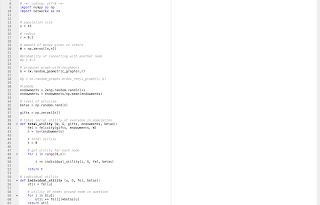What does Applied Mathematics Research Look Like?
 |
| In progress code of the model |
In my last post I mentioned that I was working with Prof. Joel Nishimura on a math research project, here is a bit about the framing of the project.
Starting with the following postulates:
- There is a spectrum caring with the two extremes, caring about oneself and caring about everyone, the distance at which an agent draws this line will be referred to as the radius of awareness (those inside will affect the agent, those outside will not)
- Agents will only act in response to the other agents within their circle of awareness, their neighborhood
- An agents utility is dependent on its amount of resources, standard of living, as well as the standard of living of those agents in its neighborhood
- A given loses some utility if other agents within its neighborhood are in distress (have a lower level of utility) and some utility is gained by transferring/donating resources to those distressed agents.
- how do you maximize utility for everyone given these circumstances manipulating only the circle of awareness?
There are an infinite number of ways that we can adjust how altruistic agents are, but this paper focuses on two:
- The weight of the amount other's utility affects you compared to your own.
- Whether you are affected by the average utility in your circle or by the minimum utility in your circle.
This will be modeled in worlds where resources are evenly distributed or unevenly distributed in a variety of manners. From those results it might be suggested that some structural frameworks make it impossible for these agents to redistribute resources in an equitable manner themselves, with the above bounds. In those models were resources are less mobile, a form of redistribution could be input (random, to the worst off, random within a bound of the worst off, etc.) and see what effect this has on those models.


Comments
Post a Comment